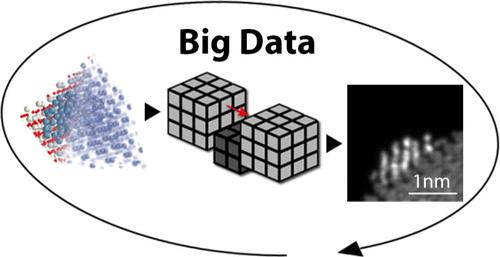用多层替代模型改进扫描透射电子显微图像中纳米颗粒大小的估计
IF 9.1
1区 材料科学
Q1 CHEMISTRY, MULTIDISCIPLINARY
引用次数: 0
摘要
模拟扫描透射电子显微镜(STEM)图像的计算成本限制了足够大的数据集的管理,以训练准确和强大的机器学习网络,以便从原子分辨率的STEM图像中进行深度特征提取。特别是对于纳米颗粒的尺寸估计,由于实验数据中尺寸、形状、结晶度、取向和动态衍射效应的巨大变化,多样化的数据集是必不可少的。为了解决这个问题,我们训练了一个3D卷积神经网络来预测来自体素化原子模型的STEM图像,与传统的多片模拟相比,实现了100倍的加速,同时保持了高图像质量。然后,我们生成了100000张合成多片图像的数据集,并研究了不同大小估计器架构的性能作为训练集大小的函数。在4000张真实图像和10万张合成图像上训练的基于resnet18的模型表现最好,将中位数尺寸估计误差从没有合成数据的9.89%降低到5.26%。本文章由计算机程序翻译,如有差异,请以英文原文为准。

Improving Nanoparticle Size Estimation from Scanning Transmission Electron Micrographs with a Multislice Surrogate Model
The computational cost of simulating scanning transmission electron microscopy (STEM) images limits the curation of large enough data sets to train accurate and robust machine learning networks for deep feature extraction from atomically resolved STEM images. For nanoparticle size estimation in particular, a diverse data set is essential due to the large variations in size, shape, crystallinity, orientation, and dynamical diffraction effects in experimental data. To address this, we train a 3D convolutional neural network to predict STEM images from voxelized atomic models, achieving a 100x speed-up compared to traditional multislice simulations while maintaining high image quality. We then generate a data set of 100.000 synthetic multislice images and investigate the performance of different size-estimator architectures as a function of training set size. A ResNet18-based model trained on 4000 real and 100.000 synthetic images is found to perform the best, reducing the median size-estimation error from 9.89% without synthetic data to 5.26%.
求助全文
通过发布文献求助,成功后即可免费获取论文全文。
去求助
来源期刊

Nano Letters
工程技术-材料科学:综合
CiteScore
16.80
自引率
2.80%
发文量
1182
审稿时长
1.4 months
期刊介绍:
Nano Letters serves as a dynamic platform for promptly disseminating original results in fundamental, applied, and emerging research across all facets of nanoscience and nanotechnology. A pivotal criterion for inclusion within Nano Letters is the convergence of at least two different areas or disciplines, ensuring a rich interdisciplinary scope. The journal is dedicated to fostering exploration in diverse areas, including:
- Experimental and theoretical findings on physical, chemical, and biological phenomena at the nanoscale
- Synthesis, characterization, and processing of organic, inorganic, polymer, and hybrid nanomaterials through physical, chemical, and biological methodologies
- Modeling and simulation of synthetic, assembly, and interaction processes
- Realization of integrated nanostructures and nano-engineered devices exhibiting advanced performance
- Applications of nanoscale materials in living and environmental systems
Nano Letters is committed to advancing and showcasing groundbreaking research that intersects various domains, fostering innovation and collaboration in the ever-evolving field of nanoscience and nanotechnology.
 求助内容:
求助内容: 应助结果提醒方式:
应助结果提醒方式:


